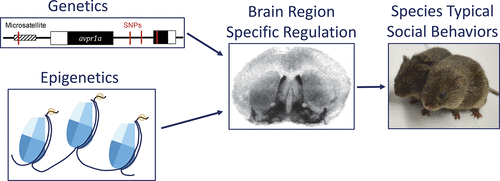当前位置:
X-MOL 学术
›
ACS Chem. Neurosci.
›
论文详情
Our official English website, www.x-mol.net, welcomes your
feedback! (Note: you will need to create a separate account there.)
Prairie Voles as a Model for Understanding the Genetic and Epigenetic Regulation of Attachment Behaviors
ACS Chemical Neuroscience ( IF 4.1 ) Pub Date : 2018-03-07 00:00:00 , DOI: 10.1021/acschemneuro.7b00475 Julie M Sadino 1 , Zoe R Donaldson 1, 2
ACS Chemical Neuroscience ( IF 4.1 ) Pub Date : 2018-03-07 00:00:00 , DOI: 10.1021/acschemneuro.7b00475 Julie M Sadino 1 , Zoe R Donaldson 1, 2
Affiliation

|
Over a lifetime, humans build relationships with family, friends, and partners that are critically important for our mental and physical health. Unlike commonly used laboratory mice and rats, Microtine rodents provide a unique model to study the neurobiology underlying pair bonding and the selective attachments that form between adults. Comparisons between monogamous prairie voles and the closely related but nonmonogamous meadow and montane voles have revealed that brain-region-specific neuropeptide receptor patterning modulates social behavior between and within species. In particular, diversity in vasopressin 1a receptor (V1aR) distribution has been linked to individual and species differences in monogamy-related behaviors such as partner preference, mate guarding, and space use. Given the importance of differential receptor expression for regulating social behavior, a critical question has emerged: What are the genetic and epigenetic mechanisms that underlie brain-region-specific receptor patterns? This review will summarize what is known about how the vasopressin (AVP)-V1aR axis regulates social behaviors via signaling in discrete brain regions. From this work, we propose that brain-region-specific regulatory mechanisms facilitate robust evolvability of V1aR expression to generate diverse sociobehavioral traits. Translationally, we provide a perspective on how these studies have contributed to our understanding of human social behaviors and how brain-region-specific regulatory mechanisms might be harnessed for targeted therapies to treat social deficits in psychiatric disorders such as depression, complicated grief, and autism spectrum disorder.
中文翻译:

草原田鼠作为理解依恋行为的遗传和表观遗传调控的模型
在一生中,人类与家人、朋友和合作伙伴建立关系,这对我们的身心健康至关重要。与常用的实验室小鼠和大鼠不同,Microtine啮齿动物提供了一个独特的模型来研究成对结合和成人之间形成的选择性依恋的神经生物学。一夫一妻制草原田鼠与密切相关但非一夫一妻制的草地和山地田鼠之间的比较表明,大脑区域特异性神经肽受体模式调节物种之间和物种内的社会行为。特别是,血管加压素 1a 受体 (V1aR) 分布的多样性与一夫一妻制相关行为的个体和物种差异有关,例如伴侣偏好、伴侣保护和空间利用。鉴于差异受体表达对调节社会行为的重要性,出现了一个关键问题:构成大脑区域特异性受体模式的遗传和表观遗传机制是什么?这篇综述将总结关于加压素 (AVP)-V1aR 轴如何通过离散大脑区域的信号传导来调节社会行为的已知信息。从这项工作中,我们提出大脑区域特异性调节机制促进 V1aR 表达的强大进化性以产生不同的社会行为特征。在转化方面,我们提供了一个观点,说明这些研究如何有助于我们理解人类社会行为,以及如何利用大脑区域特异性调节机制进行靶向治疗,以治疗抑郁症、复杂悲伤和自闭症等精神疾病的社会缺陷谱系障碍。
更新日期:2018-03-07
中文翻译:

草原田鼠作为理解依恋行为的遗传和表观遗传调控的模型
在一生中,人类与家人、朋友和合作伙伴建立关系,这对我们的身心健康至关重要。与常用的实验室小鼠和大鼠不同,Microtine啮齿动物提供了一个独特的模型来研究成对结合和成人之间形成的选择性依恋的神经生物学。一夫一妻制草原田鼠与密切相关但非一夫一妻制的草地和山地田鼠之间的比较表明,大脑区域特异性神经肽受体模式调节物种之间和物种内的社会行为。特别是,血管加压素 1a 受体 (V1aR) 分布的多样性与一夫一妻制相关行为的个体和物种差异有关,例如伴侣偏好、伴侣保护和空间利用。鉴于差异受体表达对调节社会行为的重要性,出现了一个关键问题:构成大脑区域特异性受体模式的遗传和表观遗传机制是什么?这篇综述将总结关于加压素 (AVP)-V1aR 轴如何通过离散大脑区域的信号传导来调节社会行为的已知信息。从这项工作中,我们提出大脑区域特异性调节机制促进 V1aR 表达的强大进化性以产生不同的社会行为特征。在转化方面,我们提供了一个观点,说明这些研究如何有助于我们理解人类社会行为,以及如何利用大脑区域特异性调节机制进行靶向治疗,以治疗抑郁症、复杂悲伤和自闭症等精神疾病的社会缺陷谱系障碍。











































 京公网安备 11010802027423号
京公网安备 11010802027423号